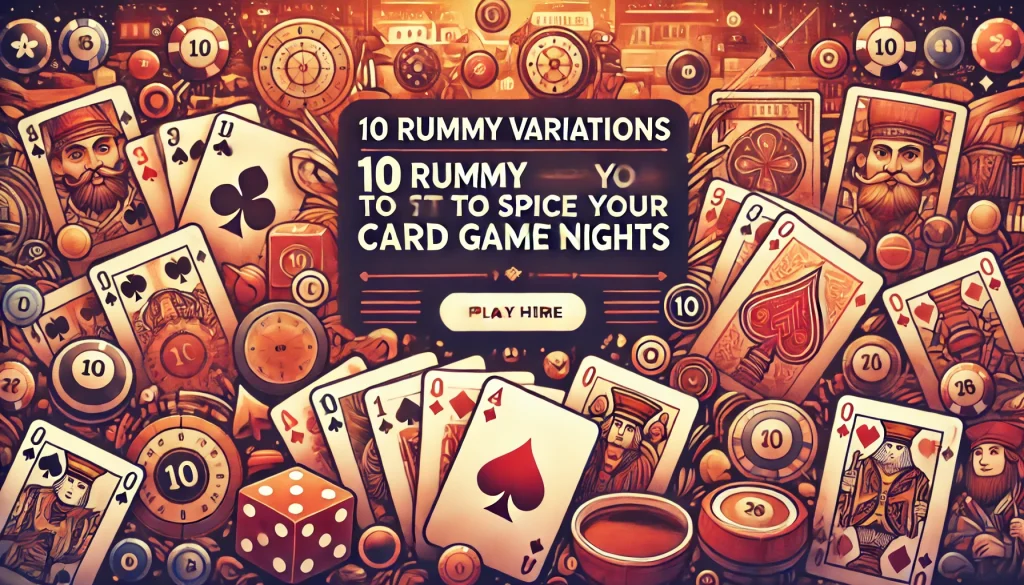Description

A fascinating card game, rummy has developed over time to accommodate a wide range of tastes and playing styles. Rummy is essentially a matching card game in which players form runs or sets using the cards that are dealt to them. The goal is to minimize the number of points remaining in hand when another player goes out while combining cards into legitimate combinations. Numerous rummy games have been created based on this basic idea, each with its own set of rules, tactics, & cultural significance.
These variations, which range from the traditional Gin Rummy to the more intricate Canasta, give players a wide variety of gaming experiences. Regional tastes and the social dynamics of card games are both reflected in the variety of rummy games. Some variations call for long-term planning & strategic depth, while others are made for fast, informal play. Indian Rummy, for example, is a popular game in South Asia that frequently uses more than two decks of cards and places an emphasis on deft melding. However, Rummikub adds a tile-based variation to the classic card game structure, making it suitable for both casual players and families. We will examine each of the different rummy variations’ special traits, regulations, & the fun they provide for players everywhere as we dig deeper.
Introduction to Rummy with Gin. One of the oldest and most well-liked rummy variations is Gin Rummy, which is distinguished by its simple rules and quick-paced gameplay. This two-player game first appeared in the United States at the beginning of the 20th century & has since become popular in both casual & competitive settings.
When one player knocks or goes “gin,” the goal of Gin Rummy is to minimize the total value of unmelded cards while forming valid sets and runs from the cards in hand. Out of a standard 52-card deck, ten cards are dealt to each player, with the remaining cards creating a draw pile. Play and strategy.
With the goal of creating melds to strengthen their hands, players alternately draw from the draw pile or the discard pile. Gin Rummy’s strategic depth comes from combining psychology & skill. Players need to be very aware of their opponent’s movements in addition to their own hands. This calls for an acute sense of observation & the capacity to predict the cards that an opponent might discard or need. Controlling risks and winning the game. Risk management is also introduced in the game; players have to choose whether to knock to end the round or keep drawing cards in an attempt to get a better hand.
The excitement of going “gin,” in which a player melds every card they have without any more unmelded cards, gives the game a new dimension of intrigue. Players of all skill levels find Gin Rummy to be a demanding and captivating game because of its strategic & daring elements. The Persistent Appeal of Gin Rummy. All things considered, Gin Rummy’s blend of strategic intricacy and simplicity has cemented its status as a popular card game across the world. In South Asia and among Indian communities around the world, Indian Rummy, also called Paplu, is a well-liked variation of the game.
Two to six players can play in this version, which usually uses two decks of cards. Like other rummy games, the main goal is still for players to use the cards they are dealt to create legitimate sets and sequences. But Indian Rummy adds special rules that make it more intricate and strategic. Before a player can declare their hand, they must form at least two sequences, one of which must be a pure sequence (one that contains no jokers).
Indian Rummy’s gameplay is distinguished by its focus on strategic discarding and deft melding. Taking into account their own hands as well as the possible needs of their opponents, players must carefully decide which cards to keep & discard. The addition of jokers offers a thrilling twist; they are extremely valuable during play and can be used as wild cards to finish sets or sequences. In order to further encourage players to meld their hands effectively, Indian Rummy frequently uses a scoring system that penalizes players for unmelded cards at the conclusion of each round.
Indian Rummy is a popular hobby for many people because it combines skill, strategy, and social interaction. The tile-based game Rummikub is a novel addition to the world of rummy variations since it blends aspects of rummy with board game mechanics. Rummikub, which was made in Romania in the 1930s by Ephraim Hertzano, has won praise from all over the world and is loved by both friends and family. In addition to two joker tiles, which can represent any number or color, there are 106 tiles in the game, numbered 1 through 13, in four different colors. By strategically placing tiles on the table and strategically controlling their own hands, players seek to form sets or runs. Rummikub’s focus on tile manipulation & spatial arrangement distinguishes it from conventional card-based rummy games.
In addition to concentrating on creating their own sets, players must search for chances to rearrange the tiles that are already on the table in order to produce novel combinations. Because players can frequently alter the outcome of the game with astute tile placements, this dynamic element promotes inventiveness and flexibility. A thrilling finish that keeps everyone interested until the very end is usually achieved when one player empties their rack by setting all of their tiles on the table. Rummikub has grown to be a popular option for family game nights & get-togethers because of its unique combination of strategy, luck, and social interaction.
Contract Rummy is an intriguing variant that uses preset contracts for every round to introduce an organized method of card melding. Due to its multi-layered gameplay mechanics, this version, which is frequently played with two decks of cards, can be quite engaging for multiple players. Players must meet certain melding requirements for every round in Contract Rummy. These requirements may include forming a specific number of sets or sequences with different levels of complexity.
Players might have to make two sets of three cards each in one round, for instance, while another might call for a run of four cards plus a set of three. Contract Rummy’s strategic depth comes from the need for players to modify their plans in response to changing contracts as the game progresses. In order to stay ahead of their opponents in subsequent rounds, players must monitor which contracts have been fulfilled as they advance through the rounds.
Contract Rummy is different from other variations where players only concentrate on their current hands because it incorporates a long-term planning element. Also, there is an additional layer of psychological play because players can frequently see what other players are aiming for based on their discards and melds. Contract Rummy is a compelling option for players who prefer a more tactical approach to card games because of its combination of structured contracts and strategic maneuvering.
An additional fascinating variation that has gained popularity worldwide, especially in Europe and some parts of Asia, is Kalooki, also referred to as Kaluki or Kalooki Rummy. Jokers & two decks of cards are usually used in this game, which makes for an exciting gameplay experience that stresses both strategic discarding and deft melding. Similar to other rummy games, Kalooki’s main goal is for players to minimize the number of unmelded cards at the end of each round while forming valid sets and runs. However, Kalooki offers special guidelines for the formation of melds and the use of jokers. Kalooki is noteworthy for its versatility when it comes to melds; players can use both natural cards—those that aren’t jokers—and wild cards—jokers—to create intricate combinations.
Because they can modify their hands according to what they draw or what others discard, players are able to employ inventive strategies. Also, Kalooki frequently has a scoring system that gives players rewards for reaching particular gameplay milestones or finishing particular melds. These components work together to create a captivating environment where players must constantly be aware of both their own and their opponents’ hands. As a result, both casual players & die-hard card enthusiasts will enjoy Kalooki’s unique fusion of strategy and social interaction.
In the 1940s, the traditional card game canasta first appeared in Uruguay and swiftly expanded throughout Latin America and beyond. This variation is usually played with two decks of cards and can be played individually with two or more players or with four players split into two partnerships. Forming “canastas,” or melds of seven or more cards of the same rank, is the main goal of Canasta. A player must also effectively manage their hand throughout the game.
As they build their melds and monitor the moves of their opponents, players alternately draw from the stockpile or discard pile. Canasta’s focus on cooperation when played in pairs and its complex scoring system, which incentivizes players for different game accomplishments, are what make it so captivating. In addition to planning how to construct their own melds, players also need to think about how to best assist their partners while impeding the advancement of their rivals. Another level of complexity is introduced by the use of wild cards, which are allowed in melds but have restrictions on how many can be used in a single meld.
Canasta’s strategic depth, social interaction, and competitive spirit make it a popular choice for card enthusiasts who value teamwork & rivalry. An inventive twist on classic rummy mechanics is provided by Progressive Rummy, an exciting variation that features progressive rounds that get more complex over time. This variation, which is usually played with two decks of cards, allows for several players to compete over a number of rounds, with contracts or objectives increasing with each round. As the game progresses, players in Progressive Rummy must modify their tactics to get around various melding requirements that get harder and harder. Players are kept interested in Progressive Rummy because it is a dynamic game where they must constantly reevaluate their hands in light of shifting contracts and potential opponent needs.
As players strive to meet progressively more difficult melding requirements over time, this variation promotes both short-term strategies—such as choosing when to draw or discard—and long-term planning. There is also an extra element of excitement as players aim for both individual triumphs and overall success throughout all rounds played because each round builds on the one before it. For both novices and experts, Progressive Rummy presents a novel twist on classic rummy gameplay with its fusion of strategy, flexibility, and social interaction.
To sum up, rummy variants offer a wide range of options for card players looking for unique gaming experiences. Every variation of rummy offers different rules & strategies to suit varying tastes and skill levels, from the simple elegance of gin rummy to the complex partnerships of canasta & the changing challenges of progressive rummy. These card games are timeless classics because they encourage social interaction while testing players’ strategic thinking skills, whether they are played competitively in tournaments or casually among friends.


